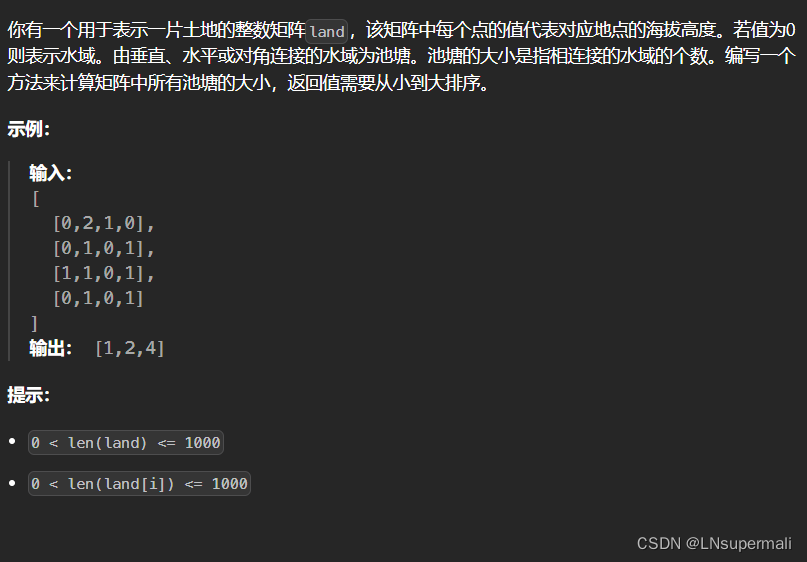Problem: 面试题 16.19. 水域大小
文章目录
- 题目描述
- 思路
- 解题方法
- 复杂度
- Code
题目描述
思路
该问题可以归纳为一类遍历二维矩阵的题目,此类中的一部分题目可以利用DFS来解决,具体到本题目(该题目可以的写法大体不变可参看前面几个题目:):
Problem: 力扣面试题 08.10. 颜色填充(java DFS解法)
Problem: 力扣200. 岛屿数量(java DFS解法)
Problem: 力扣LCR 130. 衣橱整理(DFS 解法)
具体到本题目中:
我们只需要将记录方位的数组扩展成记录上、下、左、右、左上、右上、左下、右下即可,其余操作大体一致。
解题方法
1.定义并初始化给定矩阵的行,列(rows, cols),int类型变量count(记录连通水域的个数)定义用于存储数据的List集合result。遍历二维数组land若当前位置元素为0则调用编写的DFS函数,退出DFS后将当前连通位置的水域个数添加到result中,最后将将集合中元素拷贝到一个数组中排序并返回。
2. dfs函数实现2.1 每次将当count加一,land当前位置置为1(标记当前位置是已经遍历过的合法位置)
2.2 二维数组记录八个方位int[][] directions = {{-1, 0}, {1, 0}, {0, -1}, {0, 1}, {-1, -1}, {-1, 1}, {1, -1}, {1, 1}};
2.3 for循环开始查找遍历(循环范围1-8),每次得到一个新的坐标(int newI = sr + directions[i][0];int newJ = sc + directions[i][1];)
2.4 条件判断新得到的横纵坐标不超过给定二维数组的索引范围,同时新的到的横纵坐标所在位置的值等于0则继续DFS
复杂度
时间复杂度:
O ( m n ) O(mn) O(mn)
空间复杂度:
O ( m n ) O(mn) O(mn)
Code
class Solution {//Recode the count of watersprivate int count = 0;//Recode the rows and columns of matrixprivate int rows;private int cols;/*** Get all Connected waters** @param land Given matrix* @return int[]*/public int[] pondSizes(int[][] land) {rows = land.length;cols = land[0].length;//Result listList<Integer> result = new ArrayList<>();for (int i = 0; i < rows; ++i) {for (int j = 0; j < cols; ++j) {if (land[i][j] == 0) {count = 0;dfs(i, j, land);result.add(count);}}}//Sortint[] finalResult = new int[result.size()];for (int i = 0; i < finalResult.length; ++i) {finalResult[i] = result.get(i);}Arrays.sort(finalResult);return finalResult;}/*** Access all connected waters by DFS** @param row Abscissa* @param col Ordinate* @param land Given matrix*/private void dfs(int row, int col, int[][] land) {count++;//Change the current position to 1//which shows that it has be visitedland[row][col] = 1;//Record eight bearingsint[][] directions = {{-1, 0}, {1, 0}, {0, -1}, {0, 1}, {-1, -1}, {-1, 1}, {1, -1}, {1, 1}};for (int i = 0; i < 8; ++i) {int newI = row + directions[i][0];int newJ = col + directions[i][1];if (newI >= 0 && newI < rows && newJ >= 0 && newJ < cols&& land[newI][newJ] == 0) {dfs(newI, newJ, land);}}}
}









)

)





)


